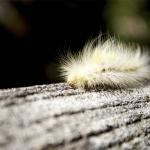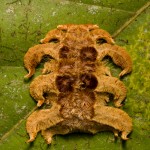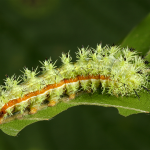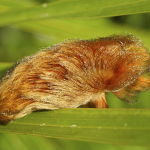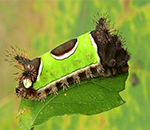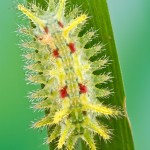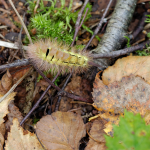Insects and Spiders
Every day, Florida poison centers receive calls about bites and stings from insects and spiders. Most bugs and spiders native to Florida are not dangerous to people. Most calls to poison centers about insect and spider bites do not need emergency medical treatment and can be safely managed at home; exceptions include cases that involve the venomous species below, and any case that involves an allergic reaction. Call the poison center for immediate advice after a bite or sting. Some callers cannot identify the creature that bit them. In these cases, poison center staff will assess the bite itself and the symptoms. Good wound care is important to prevent infection of any opening in the skin.
For more information about Florida bugs and spiders, visit the Entomology Department at the University of Florida.
Ants & Fire Ants
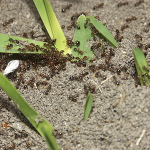 Black, brown, red, or multi-colored ants with segmented bodies
Black, brown, red, or multi-colored ants with segmented bodies
Bite Site
Itching for days, slight redness. Fire ants leave a pimple-like bump that bursts, leaving a small bruise.
Possible Symptoms
Allergic reaction or infection
First Aid
Cleanse thoroughly with soap and water. Apply wrapped ice and a paste of baking soda or meat tenderizer. Apply anti-itch products such as calamine lotion. Go to the hospital for treatment if an allergic reaction occurs.
Bees & Wasps
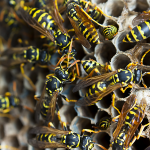 Wasps and hornets have smooth segmented bodies. Bees are fuzzy with yellow and black rings and a stinger that may be left in the wound.
Wasps and hornets have smooth segmented bodies. Bees are fuzzy with yellow and black rings and a stinger that may be left in the wound.
Sting Area
Mild swelling and redness, with pain like a needle stick
Possible Symptoms
Muscle twitching and spasms, cramps, vomiting, sweating, headache, severe trunk pain
First Aid
Remove the stinger. Cleanse the sting site(s) with soap and water. Apply cool compresses to soothe pain and swelling. Go to your nearest emergency department for treatment from an allergic reaction or a large number of stings.
Scorpions
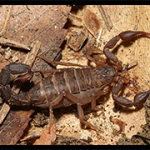 Lobster-shaped brown or black body with a stinger on tail. Florida scorpions are not venomous.
Lobster-shaped brown or black body with a stinger on tail. Florida scorpions are not venomous.
Bite Site
Pain, mild swelling
Possible Symptoms
An allergic reaction is the most common symptom. Poisonous scorpions from other states may cause weakness and paralysis.
First Aid
Cleanse the bite area with soap and water. Apply wrapped ice to soothe pain and reduce swelling.
Black Widow Spider
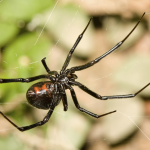 Black widow spiders are marked by their shiny black bodies with a red hourglass shape on the abdomen. There are also dull brown and red widows with orange or red circles on abdomen.
Black widow spiders are marked by their shiny black bodies with a red hourglass shape on the abdomen. There are also dull brown and red widows with orange or red circles on abdomen.
Bite Site
No mark. Pain like a needle stick.
Possible Symptoms
Muscle twitching and spasms, cramps, vomiting, sweating, headache, severe trunk pain
First Aid
Cleanse the bite site with soap and water. Apply cool compresses to reduce pain and swelling. Visit the nearest emergency department if more than local symptoms occur.
Brown Recluse Spider (not native to Florida)
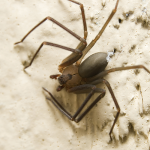 Also called Violin or Fiddleback spider, the brown recluse spider is a brown spider that is no larger than a quarter, with a dark brown violin shape on its back.
Also called Violin or Fiddleback spider, the brown recluse spider is a brown spider that is no larger than a quarter, with a dark brown violin shape on its back.
Bite Site
Red rings will form around a black blister, which will appear infected. The site will be swollen and painful. A bite from a brown recluse spider takes a long time to heal completely.
Possible Symptoms
Fever, chills, nausea and vomiting, itching, brown urine
First Aid
Cleanse the bite site with soap and water. Go immediately to your nearest emergency department or physician for a tetanus booster or wound treatment if needed.
Buck Moth Caterpillar
A large caterpillar, spanning between 1 ¾”and 2 ¼” long when mature. It is yellow-brown to purplish-black with many small white spots and a reddish head. Feeds on oak, willow and other deciduous plants.
Possible Symptoms
Some people experience severe reactions to the poison released by the spines and require medical attention. Others experience only an itching or burning sensation.
First Aid
Place clear tape over the affected area and strip off repeatedly to remove spines. Do not use the same piece of tape twice. Apply ice packs to reduce the stinging sensation, and follow with a paste of baking soda and water. If the victim has a history of hay fever, asthma or allergy, or if allergic reactions develop, contact a physician immediately.
Flannel Moth Caterpillar
This caterpillar is about 1″ long when mature. Stinging hairs are intermixed with soft hairs in diffuse tufts. Larvae are creamy white, turning dark as they mature. They feed on oak and various other shrubs and trees.
Possible Symptoms
Some people experience severe reactions to the poison released by the spines and require medical attention. Others experience only an itching or burning sensation.
First Aid
Place clear tape over the affected area and strip off repeatedly to remove spines.Do not use the same piece of tape twice. Apply ice packs to reduce the stinging sensation, and follow with a paste of baking soda and water. If the victim has a history of hay fever, asthma or allergy, or if allergic reactions develop, contact a physician immediately.
Hag Caterpillar
Light to dark brown with nine pairs (sometimes fewer) of variable-length, lateral processes, which bear the stinging hairs. It is found on various forest trees and ornamental shrubs. Not as common as the other species.
Possible Symptoms
Some people experience severe reactions to the poison released by the spines and require medical attention. Others experience only an itching or burning sensation.
First Aid
Place clear tape over the affected area and strip off repeatedly to remove spines. Do not use the same piece of tape twice. Apply ice packs to reduce the stinging sensation, and follow with a paste of baking soda and water. If the victim has a history of hay fever, asthma or allergy, or if allergic reactions develop, contact a physician immediately.
Io Moth Caterpillar
Pale green with yellow and red stripes. Often exceeds 2″ in length and is fairly stout-bodied. The netting organs are bone and flesh tubercles, and the spines are usually yellow with black tips. The spines are connected to poison glands. Ixora and rose are their favorite hosts.
Possible Symptoms
Some people experience severe reactions to the poison released by the spines and require medical attention. Others experience only an itching or burning sensation.
First Aid
Place clear tape over the affected area and strip off repeatedly to remove spines. Do not use the same piece of tape twice. Apply ice packs to reduce the stinging sensation, and follow with a paste of baking soda and water. If the victim has a history of hay fever, asthma or allergy, or if allergic reactions develop, contact a physician immediately.
Puss Caterpillar
A convex, stout-bodied larva, almost 1″ long when mature, and completely covered with gray to brown hairs. Under the soft hairs are stiff spines that are attached to poison glands. When touched, these poisonous spines break off in the skin and cause severe pain. Most often found on oaks and citrus. In Florida, there are two generations a year: one in spring and the other in fall.
Possible Symptoms
Some people experience severe reactions to the poison released by the spines and require medical attention. Others experience only an itching or burning sensation.
First Aid
Place clear tape over the affected area and strip off repeatedly to remove spines. Do not use the same piece of tape twice. Apply ice packs to reduce the stinging sensation, and follow with a paste of baking soda and water. If the victim has a history of hay fever, asthma or allergy, or if allergic reactions develop, contact a physician immediately.
Saddleback Caterpillar
Brown with a green back and flanks, on which there is a conspicuous brown oval central area that usually is bordered with white. The brown spot looks like a saddle, and the green area looks like a saddle blanket. It may exceed 1″ in length and is stout-bodied. The primary nettling hairs are borne on the back of paired fleshy protuberances toward the front and hind ends of the body. There is also a row of smaller stinging organs on each side.
Possible Symptoms
Some people experience severe reactions to the poison released by the spines and require medical attention. Others experience only an itching or burning sensation.
First Aid
Place clear tape over the affected area and strip off repeatedly to remove spines. Do not use the same piece of tape twice. Apply ice packs to reduce the stinging sensation, and follow with a paste of baking soda and water. If the victim has a history of hay fever, asthma or allergy, or if allergic reactions develop, contact a physician immediately.
Spiny Oak-Slug Caterpillar
A pale-green caterpillar about ¾” long when mature. Favorite plants include oak, willow and other deciduous plants.
Possible Symptoms
Some people experience severe reactions to the poison released by the spines and require medical attention. Others experience only an itching or burning sensation.
First Aid
Place clear tape over the affected area and strip off repeatedly to remove spines. Do not use the same piece of tape twice. Apply ice packs to reduce the stinging sensation, and follow with a paste of baking soda and water. If the victim has a history of hay fever, asthma or allergy, or if allergic reactions develop, contact a physician immediately.
Tussock Moth Caterpillar
Small, dimorphic caterpillars with prominent antennae. Females have short wings, but cannot fly.
Possible Symptoms
Contact with the caterpillar’s hairs can result in welts that appear quickly (usually within a few minutes) and go away within a day. Itching and redness may continue for an additional 24-48 hours. Individuals with severe sensitivity may experience swelling and nausea.
First Aid
Place clear tape over the affected area and strip off repeatedly to remove spines. Do not use the same piece of tape twice. Apply ice packs to reduce the stinging sensation, and follow with a paste of baking soda and water. If the victim has a history of hay fever, asthma or allergy, or if allergic reactions develop, contact a physician immediately.



